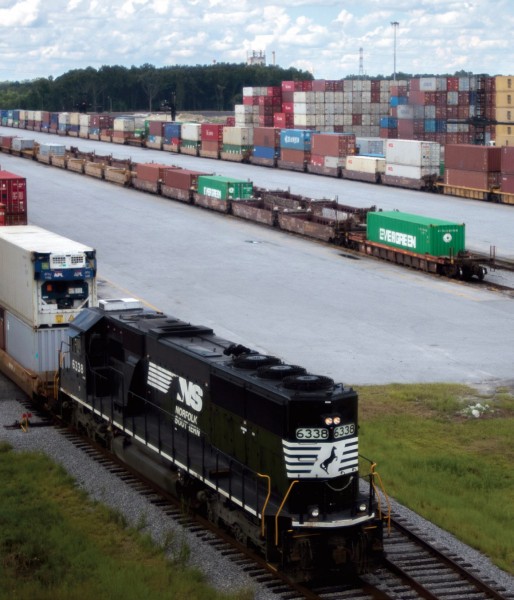From development of a consolidated rail terminal at the Port of Savannah to expansion of inland port capabilities, the Georgia Ports Authority is assertively building upon its intermodal links.
Early construction activity has begun on the GPA’s $128 million Mason Mega Rail project at the Port of Savannah’s Garden City Terminal, already the South Atlantic region’s busiest intermodal gateway, handling 38 trains per week of import and export freight.

Funded in part by a $44 million federal grant, the endeavor also entails building of bridges carrying eight tracks over a canal and installation of eight rail-mounted gantry cranes, each to span nine tracks for improved efficiency moving containers from train to truck.
The completed project will double rail capacity at the Garden City Terminal to 1 million lifts per year and facilitate ready accommodation of 10,000-foot-long unit trains, according to GPA officials, while allowing all rail switching to be brought onto the terminal and improving vehicle traffic flow around the port.
“Our ability to build longer trains on terminal will incentivize rail carriers to expand the service area best served by the Port of Savannah—positioning Savannah to rapidly increase service to an arc of inland markets, from Atlanta to Memphis, St. Louis, Chicago and the Ohio Valley,” said John Trent, GPA’s senior director of strategic operations and safety.
The on-terminal Savannah project is being buttressed by development of additional inland port infrastructure.
The GPA looks to begin operations in the fall at a new inland rail facility, the CSX-served Appalachian Regional Port, on 42 acres in Murray County, proximate to Interstate 75 about 85 miles north-northwest of Atlanta, therewith opening additional markets for GPA across Alabama, Tennessee and Kentucky.
“Because it is located in an industrial belt – including the production and export of carpet and flooring, automobiles and tires – the Appalachian Regional Port will make those commodities more competitive in the global market, while reducing emissions,” said GPA Executive Director Griff Lynch.
The cost reductions emanate from the efficiency of rail, by which hundreds of containers can be moved at once. Additionally, once a manufacturer has emptied a container of cargo, that container may be returned to the inland port rather than paying for drayage back to the coast. This should also shorten the time a cargo owner must pay the container lease rate.
GPA officials have computed that each container moved by rail to the Appalachian Regional Port will offset 355 truck miles on Georgia highways, saving more than 8 million truck miles in the first year while alleviating highway congestion around Atlanta. The facility is to open with an initial capacity of 50,000 containers per year, with a 10-year development plan calling for doubling that capacity.
The Murray County installation is to join the established inland port in south-central Georgia operated by Cordele Intermodal Services. Served by short-line rail providers, CIS operates on 40 acres with an option to expand. CIS supplies the Kia manufacturing plant in West Point, Georgia, with parts imported through Savannah, saving more than 6 million truck miles each year.
“As our network continues to grow,” Lynch said, “we expect to announce in 2018 the site of our next two inland terminals.”

_Alliance_-_127500_-_8518a8cb53bfa1ee3241a9389b0c47f7b53ad9ce_lqip.png)



